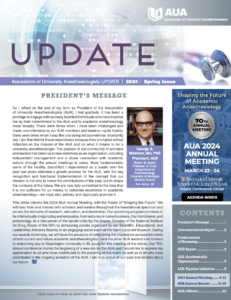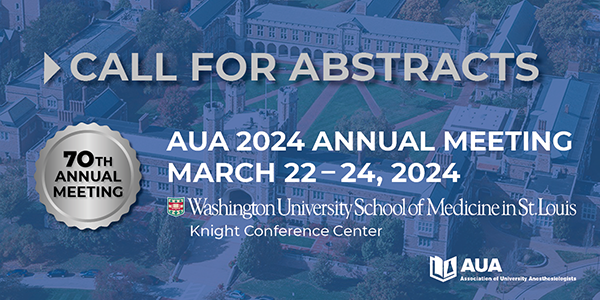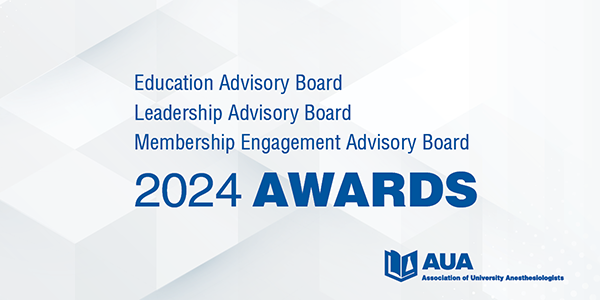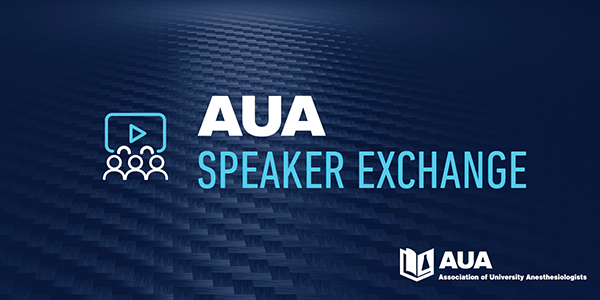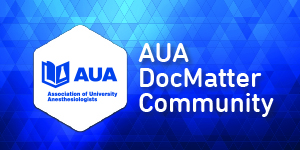AUA and FAER: Two Sides of the Same Coin
I’ve often heard it said that in research, “publications (or grants) are the currency of the realm.” Currency in this phrase could be shorthand to mean a few things. The metric of value, for example. Or by how investigators are judged by promotions committees, our peers, and our specialty. Without grant support it’s hard to envision a path for serious scientific contributions that will shape future understanding or clinical care in the specialty. And without sharing meaningful knowledge from research through peer reviewed publications, the work is wasted.
AUA and FAER provide a different kind of currency to a different aspect of the research realm, and we do so in such a complementary fashion that it is indeed as if we were two sides of the same coin. On the one side, AUA recognizes academic excellence, especially in research, and provides a community for discussion and sharing of exciting new knowledge and ideas with a goal to grow the size and impact of research in our medical specialty. As such, AUA elects new members annually and engages them through regular communications and at an outstanding annual meeting. AUA also impacts the specialty at large and all of medicine through informal and oftentimes formal participation in committees, task forces, and advocacy efforts of national societies and organizations seeking input from the academic research community.
On the other side of the coin, FAER also strives to grow the size and impact of research in our medical specialty, primarily by bringing new investigators to the specialty and providing support to the departments which are nurturing them at the beginning of their careers. As such, we support medical students to perform research in anesthesiology and offer both medical students and residents special sessions at the American Society of Anesthesiologists (ASA) annual meeting where they can learn more about research careers and present their own work. But primarily we support new investigators, partnering with their departments to provide protected time for 2 years and thereby helping them to establish, in a mentored environment, the tools and preliminary data to compete for extramural funding. If you will, FAER grants represent the currency in the realm of research career development while AUA membership represents the currency in the realm of research excellence in our specialty.
It’s not surprising, then that AUA and FAER are so closely associated. For over 30 years, dating from FAER’s inception, AUA has supported FAER monetarily, totaling nearly $900,000 over this period. We are extremely grateful for this continued support. Individuals often play leadership roles in each organization. For example, the AUA President for 7 of the past 10 years had previously served as a member of the FAER Board of Directors. Most years the Spring meeting of the FAER Board of Directors occurs on the day prior to the AUA annual meeting. Mentoring is a clear focus of both organizations and each sponsors scientific and mentoring sessions at national and international meetings.
The FAER Board of Directors embarked in 2016 on a strategic process to evaluate and update existing programs and establish new ones to better meet its mission. We began at the heart of FAER with a review of the Mentored Research Training Grant (MRTG), forming a task force which included several AUA members. The task force spent 5 months performing research and presenting the Board with a series of questions and possible answers based on the results. The Board made two fundamental changes. First, the amount of FAER support for the MRTG increased over 40% from $175,000 to $250,000 per grant. FAER recognizes that this still represents a minority of the total support for research resources and the guaranteed 75% protected time from clinical duties that is required for these clinicians. Nonetheless, the increased FAER funding for the MRTG it is now a larger minority of the total cost and we hope that this increased monetary support allows more departments to participate in this program. We are encouraged by the large increase in applications received for this award during the 2019 Spring cycle, to be reviewed in April 2019, and take it as a sign that this change was needed and may succeed in this aim.
FAER MRTG: Application numbers in the year before and first year of change in amount of grant support
| $175,000 Award | $250,000 Award | |
|---|---|---|
| Fall Applications | 10 | 14 |
| Spring Applications | 14 | 20 |
The second change to the FAER Mentored Research Training Grant approved by our Board was to take a page out of the AUA playbook. We recognized that AUA succeeds by creating a needed space that serves the academic community and that many other research career development granting organizations have fostered a similar community of awardees through a self-standing meeting. We interviewed leaders of such organizations, including the National Institute on Ageing, the Rita Allen Foundation, the Robert Wood Johnson Fellowship, and the Alzheimer’s Association, learning what has and has not worked for them. The FAER Board approved creation of an annual MRTG meeting beginning in July 2019 in Washington, DC. It will focus on creating a network which, like the AUA, may last for many years as individuals advance in their careers. The first meeting will be limited to the 20 currently active FAER MRTG awardees with the intent to evaluate and likely expand this program in coming years.
In 2018 the FAER Board used a similar task force-based process to review the medical student and resident programs and made several changes which go into effect this year. Most importantly, 50 medical students and a similar number of residents will present their own research as part of a day of research on Sunday at the ASA annual meeting. The morning will be devoted to early-career development discussions geared towards these FAER-supported individuals and the early stage anesthesia scholars (eSAS) group, who participated in creating the program. The afternoon will consist of PAPER poster presentations by medical students followed by an ice cream social break and then poster presentations by residents. We hope you will stop by throughout the day, but especially when these young individuals are presenting which, for many of them, will be their first scientific presentation and for many of whom will be doing so under mentorship of AUA members!
A Day for New Researchers: Schedule at a Glance
| FAER/eSAS sessions | 8:00am - 11:00am |
| Break | 11:00am - 12:30pm |
| Medical Student Posters | 12:30pm - 2:00pm |
| FAER/eSAS session | 2:00pm - 3:30pm |
| Networking Coffee and Ice Cream Break | 3:30pm - 4:00pm |
| Resident Posters | 4:00pn - 5:30pm |
| Poster Awards | 5:30pm - 5:45pm |
We also decided to expand our medical student program by inviting up to 12 students performing a summer of research in anesthesiology departments through their institution’s NIH T35 grant and by attending the MD/PhD National Student Conference to present key research questions in our specialty.
So as you can see through all of our related activities, FAER and AUA really are two sides of the same coin. A key currency of the realm of research in anesthesiology. To learn more about FAER and what we are doing, visit www.FAER.org.

